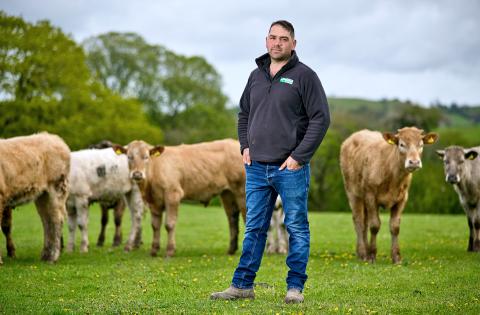HCC scholar, Tesco Future Farmer, NFU Next Generation board member and former Farmers Weekly focus farmer Tom Jones wants to create a sustainable future for his young family. The son of an upland sheep and suckler beef farm, Tom’s key focus for his exchange visit is on the efficient production of red meat on a low-cost forage-based system that improves the soil, maintains water quality and enhances the environment. He wants to improve suckler cow profitability through having a better understanding of factors that affect this including genetics, recording/selection systems and grazing management.
“Our goals are to improve the maternal efficiency of the suckler herd to improve both performance and profitability and longer-term, to shift back to native breed cattle.”
EXECUTIVE SUMMARY
Welsh suckler beef farmer says low input cows are key to industry’s future
A livestock farmer believes the future of the Welsh suckler beef industry lies with low input cows that can live off home-grown feed and deliver on environmental goals.
“The days of high input cows are gone, extremes are out,’’ reckons third generation farmer Tom Jones, who runs a herd of 50 cows on the family farm, Pentre Farm, near Lake Vyrnwy.
“How can we claim to be providing environmental benefits if we’re reliant on inputs?’’
Tom was awarded a place on the Farming Connect Management Exchange programme to look what improvements can be made to suckler cow profitability.
His family’s suckler herd had been made up of Continental cattle but native breeds, predominantly Aberdeen Angus heifers, have been sourced as replacements over the last three years.
Charolais and Aberdeen Angus stock bulls are used.
Stud stock, says Tom, should be reared in an environment equivalent, if not tougher, than that in which their progeny is expected to survive in commercially.
All progeny are sold as stores at 18 months.
“The prime focus is the efficient production of red meat on a low cost, forage-based system that enhances our soil, maintains water quality and enhances our environment,’’ says Tom.
His Management Exchange research took him to beef farms in Scotland with systems that revolve around cattle that thrive from forage.
Tom noted that one of the features that made those businesses successful was getting the basics right. “A simple system is often the most profitable,’’ he says.
His aim had been to run a closed herd but, as a result of his study, he believes that for speed of genetic improvement, he needs to tap into the hard work done by others by sourcing replacements from high health status herd with similar goals.
“The right genetics are out there,’’ he says.
For the current herd, he says he needs to increase pressure on their performance to firstly ensure that they are earning their keep and secondly to allow for a quicker change over to new genetics.
“We must also be strict with the type of cow we are also breeding or purchasing,’’ he says.
Attention to detail on structure, feet and teat placement is vital, he adds.
“Striking a balance between feminine cows that are easy calving and are low input versus producing masculine steers with conformation and high performance that the market pays a premium for is a fine line that we must ensure we don’t stray too far from.’’
MANAGEMENT EXCHANGE REPORT


